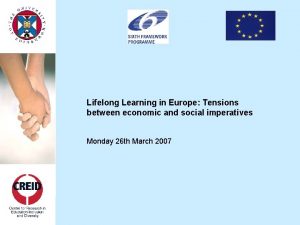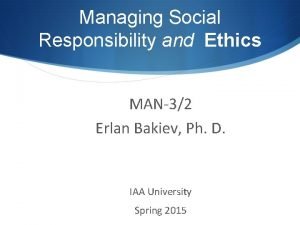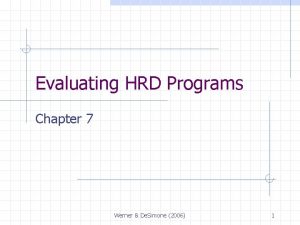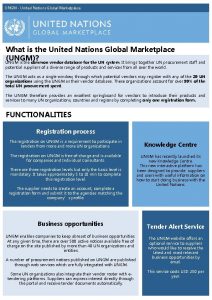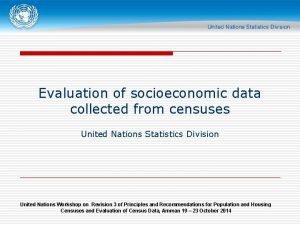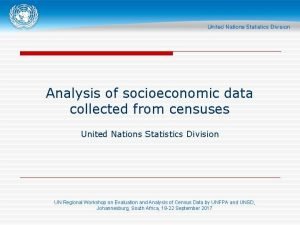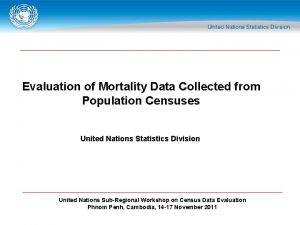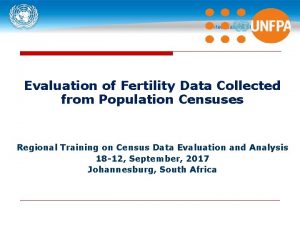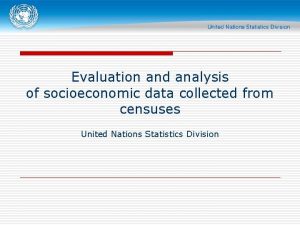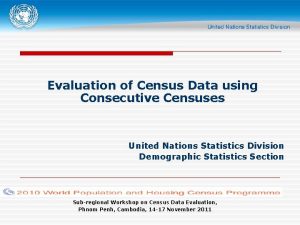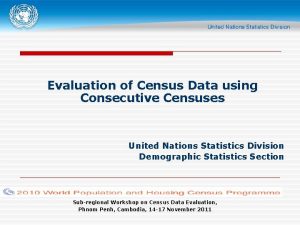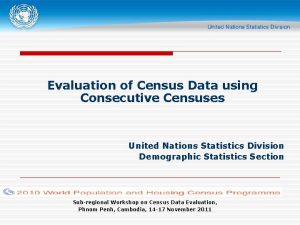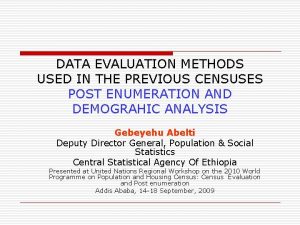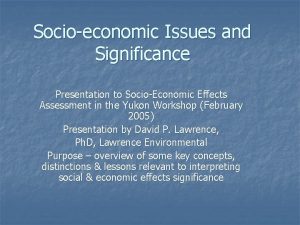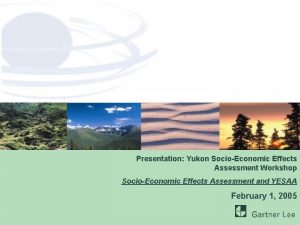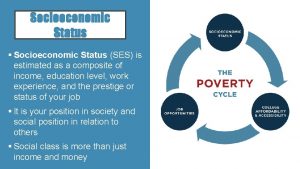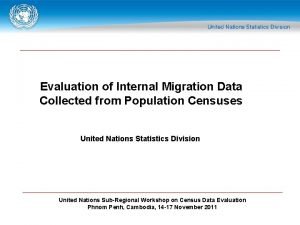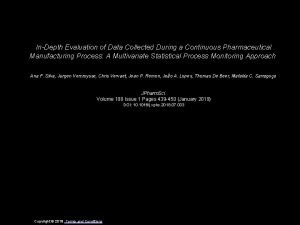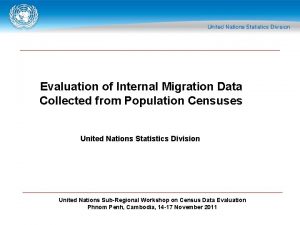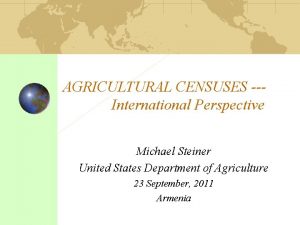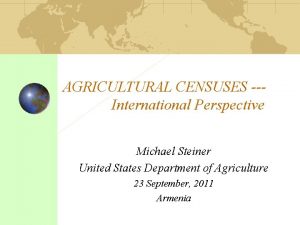Evaluation of socioeconomic data collected from censuses United
































- Slides: 32

Evaluation of socioeconomic data collected from censuses United Nations Statistics Division United Nations Workshop on Revision 3 of Principles and Recommendations for Population and Housing Censuses and Evaluation of Census Data, Amman 19 – 23 October 2014

What can be done to check data quality? § § § Check the internal consistency of the data § Whether plausible when tabulated or cross-tabulated with other characteristics Compare with other sources -indirect comparison § Graph the derived indicators § Cohort analysis of certain indicators § Disaggregate by sex and age Compare with other sources- direct comparison § Post enumeration surveys, where people were reinterviewed and content of the census responses is verified § Matching records with other sources United Nations Workshop on Revision 3 of Principles and Recommendations for Population and Housing Censuses and Evaluation of Census Data, Amman 19 – 23 October 2014

Main types of socioeconomic characteristics from censuses § § § Demographic and social characteristics § § § Age Sex Marital status § § § Literacy School attendance Educational attainment § § Economic activity status (labor force participation) Occupation Industry Status in employment Educational characteristics Economic characteristics Core topics from the Principles and Recommendations for Population and Housing Censuses, Rev. 2 United Nations Workshop on Revision 3 of Principles and Recommendations for Population and Housing Censuses and Evaluation of Census Data, Amman 19 – 23 October 2014

Education q Three core concepts; n Literacy – ability to read and write a short, simple statement n School attendance – current, regular attendance at an accredited educational institution or program o Distinguished from enrollment, which means that the student is officially registered at school, not necessarily that s/he actually goes to class n Educational attainment – highest grade completed within the most advanced level reached in the educational system United Nations Workshop on Revision 3 of Principles and Recommendations for Population and Housing Censuses and Evaluation of Census Data, Amman 19 – 23 October 2014

Education q How to evaluate the quality of data: n Cohort analysis n Comparison of education indicators calculated from the census and other sources of data –household surveys, administrative registers n Plausibility in the distribution of data United Nations Workshop on Revision 3 of Principles and Recommendations for Population and Housing Censuses and Evaluation of Census Data, Amman 19 – 23 October 2014

Cohort approach q Use the demographic concept of birth cohort to generate time series data for people who were born in the same year/period by their completed level of education and literacy q Analyze successive census data by cohorts - if they show similar level for certain level of education while age increases q Assumption: n People do not continue education after reaching certain age - based on educational system in a country United Nations Workshop on Revision 3 of Principles and Recommendations for Population and Housing Censuses and Evaluation of Census Data, Amman 19 – 23 October 2014

Cohort approach q Data requirement : Consecutive population censuses by age groups, sex and literacy status and completed level of education Literate Population, Morocco, Male q Example for two successive censuses conducted in 1994 and 2004 Age group 15 -19 20 -24 25 -29 30 -34 35 -39 40 -44 45 -49 50 -54 55 -59 60 -64 65 -69 70 -74 1994 Census 2004 Census 1, 001, 617 1319162 862, 136 1097725 606, 808 884574 498, 536 772151 436, 522 595152 354, 813 527018 192, 203 448700 134, 027 362123 99, 384 184222 74, 235 125762 40, 602 81536 27, 775 56054 United Nations Workshop on Revision 3 of Principles and Recommendations for Population and Housing Censuses and Evaluation of Census Data, Amman 19 – 23 October 2014

Cohort approach Literate Population, Morocco, Male Age group 15 -19 20 -24 25 -29 30 -34 35 -39 40 -44 45 -49 50 -54 55 -59 60 -64 65 -69 70 -74 1994 Census 2004 Census 1, 001, 617 1319162 862, 136 1097725 606, 808 884574 498, 536 772151 436, 522 595152 354, 813 527018 192, 203 448700 134, 027 362123 99, 384 184222 74, 235 125762 40, 602 81536 27, 775 56054 Re- organization of data by birth cohorts Literate Population, Morocco, Male Age group 15 -19 20 -24 25 -29 30 -34 35 -39 40 -44 45 -49 50 -54 55 -59 60 -64 65 -69 70 -74 1994 Census 2004 Census Year of birth 1001617 1319162 1984 -89 862136 1097725 1979 -84 606808 884, 574 1974 -79 498536 772, 151 1969 -74 436522 595, 152 1964 -69 354813 527, 018 1959 -64 192203 448, 700 1954 -59 134027 362, 123 1949 -54 99384 184, 222 1944 -49 74235 125, 762 1939 -44 40602 81, 536 1934 -39 27775 56, 054 1929 -34 United Nations Workshop on Revision 3 of Principles and Recommendations for Population and Housing Censuses and Evaluation of Census Data, Amman 19 – 23 October 2014

Cohort approach Impact of out-migration among literate population ? United Nations Workshop on Revision 3 of Principles and Recommendations for Population and Housing Censuses and Evaluation of Census Data, Amman 19 – 23 October 2014

Cohort approach 1994 Census Year of Age birth misreporting? 1974 -79 Impact of international out -migration ? Expected pattern at older ages because of the effect of high mortality risk 1969 -74 1964 -69 1959 -64 1954 -59 1949 -54 1944 -49 1939 -44 1934 -39 1929 -34 2004 Census Male 1001617 884574 862136 772151 606808 595152 498536 527018 436522 448700 354813 362123 192203 184222 134027 125762 99384 81536 74235 56054 Cohort survival ratio (2004/1994) 0. 88 0. 90 0. 98 1. 06 1. 03 1. 02 0. 96 0. 94 0. 82 0. 76 United Nations Workshop on Revision 3 of Principles and Recommendations for Population and Housing Censuses and Evaluation of Census Data, Amman 19 – 23 October 2014

Cohort approach Educational attainment, Republic of Korea, 2000, 2005 and 2010 censuses United Nations Workshop on Revision 3 of Principles and Recommendations for Population and Housing Censuses and Evaluation of Census Data, Amman 19 – 23 October 2014

Cohort approach Educational attainment, Republic of Korea, 2000, 2005 and 2010 censuses United Nations Workshop on Revision 3 of Principles and Recommendations for Population and Housing Censuses and Evaluation of Census Data, Amman 19 – 23 October 2014

Internal consistency Egypt, 2006 census Scool attendance, Female 1000 100. 0 900 95. 0 800 90. 0 700 85. 0 Age 11 600 500 80. 0 75. 0 Age 14 400 70. 0 300 65. 0 Thousands Scool attendance, Male 900 100. 0 800 95. 0 700 90. 0 500 60. 0 100 55. 0 100 50. 0 0 7 Total 8 9 10 11 12 13 14 15 16 17 18 Attending Percent 75. 0 70. 0 300 200 6 80. 0 Age 14 400 200 0 85. 0 Age 11 600 65. 0 60. 0 55. 0 50. 0 6 7 8 9 10 11 12 13 14 15 16 17 18 Total Attending Percent United Nations Workshop on Revision 3 of Principles and Recommendations for Population and Housing Censuses and Evaluation of Census Data, Amman 19 – 23 October 2014

Comparison with other sources q The possible sources of data for comparisons are: § Population registers, § Vital registration systems, § School enrollment data, § Citizen identification systems, § Social security/health systems § Existing household surveys q Serious discrepancies between census and survey/administrative distributions for census topics are indicative of error in one or both sets of data - cause(s) should be investigated United Nations Workshop on Revision 3 of Principles and Recommendations for Population and Housing Censuses and Evaluation of Census Data, Amman 19 – 23 October 2014

Comparison with other sources q Close investigation on the followings: § The definitions used for socioeconomic data can have a significant impact on results – make sure that definitions used are consistent or investigate how differences in definitions would affect n Consistency in how the question(s) is phrased - the terms used for the questions can be key factor in comparison with other sources n Consistency in reference time-investigate how the differences in reference time would affect the results of evaluation United Nations Workshop on Revision 3 of Principles and Recommendations for Population and Housing Censuses and Evaluation of Census Data, Amman 19 – 23 October 2014

Comparisons with existing household surveys q The rationale for using existing household surveys to evaluate a census on a non-matching basis lies in the fact that n sample surveys are often less affected by nonsampling error than censuses due to the better operational control, qualified field staff with intensive tranning programme n therefore, survey data on population characteristics also measured by a census often are considered to be more accurate than the census results United Nations Workshop on Revision 3 of Principles and Recommendations for Population and Housing Censuses and Evaluation of Census Data, Amman 19 – 23 October 2014

Comparison with other sources Ø Census results indicate slightly lower level than the DHS Ø Census results are highly consistent with the results of DHS United Nations Workshop on Revision 3 of Principles and Recommendations for Population and Housing Censuses and Evaluation of Census Data, Amman 19 – 23 October 2014

Economic activity q q Activity status – a person’s relationship to economic activity during a short reference period (typically a week) n Employed – a person who worked a defined, minimum amount of time over the reference period (may be as little as an hour) n Unemployed – a person who did not work the minimum amount of time during the reference period but was willing and able to work and looking for a job n Inactive (out of labor force)– a person who did not work the minimum amount of time during the reference period and did not want to work/was not looking for work Both the employed and the unemployed are economically active! n Employed + unemployed = labor force United Nations Workshop on Revision 3 of Principles and Recommendations for Population and Housing Censuses and Evaluation of Census Data, Amman 19 – 23 October 2014

Economic activity q Difficulties: n What does “work” mean? o Goods and services produced for the market o Goods produced for own-use (replacing need to buy on market) Ø In practice, this is quite difficult to measure, especially in areas with large agricultural or informal economies Ø Women’s home-based production in particular is often undercounted in surveys n What does “looking for a job” mean? o E. g. some persons may have registered at a government labor office months ago, but done nothing else. Are they looking for a job? United Nations Workshop on Revision 3 of Principles and Recommendations for Population and Housing Censuses and Evaluation of Census Data, Amman 19 – 23 October 2014

Additional economic characteristics q Occupation – type of work that the person performs (most recent ISCO classification) q Industry – kind of production that the establishment in which the person works engages in (most recent ISIC classification) q Status in employment – type of contract the person has with his place of work (ICSE from the ILO) n Recommended categories: Employee; Employer; Own-account worker; Contributing family worker; Members of producer cooperatives; Persons not classifiable by status Source: Principles and Recommendations for Population and Housing Censuses, Rev. 2, United Nations, 2008 United Nations Workshop on Revision 3 of Principles and Recommendations for Population and Housing Censuses and Evaluation of Census Data, Amman 19 – 23 October 2014

Example: Egypt labor force measurement (2006) Egypt Labor Market Panel Survey (ELMPS) 2006 vs. Egypt Census 2006 United Nations Workshop on Revision 3 of Principles and Recommendations for Population and Housing Censuses and Evaluation of Census Data, Amman 19 – 23 October 2014

Comparison with survey data Egypt Labor Market Panel Surveys and Censuses Data source: Minnesota Population Center. Integrated Public Use Microdata Series, International: Version 6. 1 (IPUMS International, with CAPMAS Egypt) and Egypt Labor Market Panel Survey (ELMPS, Economic Research Forum, Egypt) United Nations Workshop on Revision 3 of Principles and Recommendations for Population and Housing Censuses and Evaluation of Census Data, Amman 19 – 23 October 2014

Comparison with survey data Census result is consistent with ELMPSmarket, but not with ELMPS-extended – reasons? United Nations Workshop on Revision 3 of Principles and Recommendations for Population and Housing Censuses and Evaluation of Census Data, Amman 19 – 23 October 2014

Comparison with survey data q Two definitions of the labor force: n The market labor force includes all those who are either engaged in economic activity for purposes of market exchange or seeking such work n The extended labor force includes those engaged in “the production and processing of primary products, whether for the market, for barter, or for their own consumption; the production of all other goods and services for the market; and, in the case of households that produce such goods and services for the market, the corresponding production for their own consumption. ” (ILO, 1982) n The distinction between the two definitions is particularly salient for women in Egypt, many of whom engage in animal husbandry and the processing of dairy products for purposes of household consumption and are thus counted as employed in the extended definition of the labor force Source: Economic Research Forum, 2007, Labor Supply, Employment and Unemployment in the Egyptian Economy, 1988 -2006, Ragui Assaad, working paper no. 0701 United Nations Workshop on Revision 3 of Principles and Recommendations for Population and Housing Censuses and Evaluation of Census Data, Amman 19 – 23 October 2014

Marital status q Marital status is the personal status of each individual in relation to the marriage laws or customs of the country. The categories of marital status should at least include the following: n n n Single (never married) Married but separated-comprise both legally and de facto separated Widowed and not married Divorced and not married United Nations Workshop on Revision 3 of Principles and Recommendations for Population and Housing Censuses and Evaluation of Census Data, Amman 19 – 23 October 2014

Internal consistency control Expected pattern • smooth declining with ages • females are getting married in younger ages than males • males are getting married slightly younger ages in rural areas compared to urban areas United Nations Workshop on Revision 3 of Principles and Recommendations for Population and Housing Censuses and Evaluation of Census Data, Amman 19 – 23 October 2014

Internal consistency control 1994 Population and Housing Census of Tunisia Proportion of widowed men United Nations Workshop on Revision 3 of Principles and Recommendations for Population and Housing Censuses and Evaluation of Census Data, Amman 19 – 23 October 2014

Comparison with survey data § Very similar patter between the census and DHS § Slight difference in the last age group United Nations Workshop on Revision 3 of Principles and Recommendations for Population and Housing Censuses and Evaluation of Census Data, Amman 19 – 23 October 2014

Singulate Mean Age at First Marriage (SMAFM) q Technique for estimating the mean age at first marriage when actual dates of marriage are not available n Is a period measure (uses a synthetic cohort) q Very simple data requirements: n Total number of women by 5 -year age groups n Total number of ever-married women by 5 -year age groups United Nations Workshop on Revision 3 of Principles and Recommendations for Population and Housing Censuses and Evaluation of Census Data, Amman 19 – 23 October 2014

SMAFM calculation (1) PEMult Source: Wachter, Ken, Essential Demographic Methods, Data from United Nations Demographic Yearbook United Nations Workshop on Revision 3 of Principles and Recommendations for Population and Housing Censuses and Evaluation of Census Data, Amman 19 – 23 October 2014

SMAFM calculation (2) United Nations Workshop on Revision 3 of Principles and Recommendations for Population and Housing Censuses and Evaluation of Census Data, Amman 19 – 23 October 2014

Some remarks q Census results are closely connected with other areas of statistical activities, therefore supplementary information about the census should be provided to the users for clarification of comparability of census data with previous censuses and other data sources q Further analysis for interpreting the findings United Nations Workshop on Revision 3 of Principles and Recommendations for Population and Housing Censuses and Evaluation of Census Data, Amman 19 – 23 October 2014
 What is quantitative example
What is quantitative example Socioeconomic model
Socioeconomic model Socioeconomic examples
Socioeconomic examples The status fridge
The status fridge A personality measure of a person's convictions is
A personality measure of a person's convictions is Scientists recently discovered that rocks collected
Scientists recently discovered that rocks collected How are ballistics collected
How are ballistics collected What is skimming and scanning
What is skimming and scanning Demonstrative and possessive pronoun
Demonstrative and possessive pronoun United states core data for interoperability
United states core data for interoperability Collecting highly parallel data for paraphrase evaluation
Collecting highly parallel data for paraphrase evaluation Purpose of hrd evaluation
Purpose of hrd evaluation Was the united states on the axis powers or allied powers?
Was the united states on the axis powers or allied powers? Settlement patterns
Settlement patterns U.k full name
U.k full name Ahli united bank bahrain careers
Ahli united bank bahrain careers Slave state
Slave state United kingdom vs great britain difference
United kingdom vs great britain difference Uhcstrc01
Uhcstrc01 United kingdom
United kingdom Pro soccer us
Pro soccer us Marshall case
Marshall case United states student association
United states student association James e. casey
James e. casey United nations
United nations Undss usg
Undss usg Wesleyan quadrilateral
Wesleyan quadrilateral United healthcare underwritten by golden rule
United healthcare underwritten by golden rule Lakeland care district
Lakeland care district Unicef is mandated
Unicef is mandated Ungm
Ungm Security vetting services
Security vetting services The united states ought to provide a universal basic income
The united states ought to provide a universal basic income

